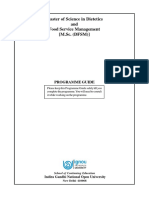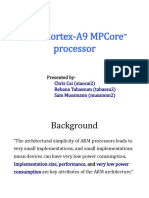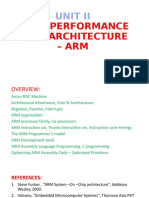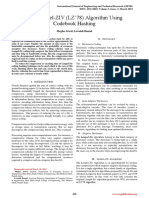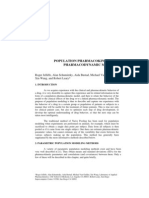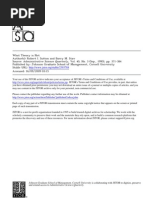Design and Implementation Af LZW Data Compression Algorithm
Uploaded by
Mandy DiazDesign and Implementation Af LZW Data Compression Algorithm
Uploaded by
Mandy DiazInternational Journal of Information Sciences and Techniques (IJIST) Vol.2, No.
4, July 2012
Design and Implementation of LZW Data Compression Algorithm
Simrandeep kaur, Student1 ; V.Sulochana Verma ,Project Consultant2
Academic and Consultancy Services Division C-DAC Mohali, Punjab India
Email: simrandeepkaur25@yahoo.com1; Email: suchivlsi@gmail.com2
Abstract
LZW is dictionary based algorithm, which is lossless in nature and incorporated as the standard of the consultative committee on International telegraphy and telephony, which is implemented in this paper. Here, the designed dictionary is based on content addressable memory (CAM) array. Furthermore, the code for each character is available in the dictionary which utilizes less number of bits (5 bits) than its ASCII code. In this paper, LZW data compression algorithm is implemented by finite state machine, thus the text data can be effectively compressed. Accurate simulation results are obtained using Xilinx tools which show an improvement in lossless data compression scheme by reducing storage space to 60.25% and increasing the compression rate by 30.3%.
Keywords
Compression rate, LZW codes and Binary text.
1. Introduction
Data compression is often referred to as coding, where coding is general term showing any special representation of data which satisfies a given need. Information theory is defined as the study of efficient coding. Data compression may be viewed as a branch of information theory in which the primary objective is to minimize the amount of data to be transmitted. Data compression has an important role in the area of transmission and storage. It plays a key role in information technology. The reduction of redundancies in data representation in order to decrease data storage requirement is defined as data compression. It used less usage of resources such as memory space or transmission capacity. Data compression is classified as lossless and lossy compression. Lossless compression is used for text and lossy compression for image. In 1980, Terry Welch invented LZW algorithm which became the popular technique for generalpurpose compression systems. It was used in programs such as PKZIP as well as in hardware devices. Lempel-Ziv-Welch proposed a variant of LZ78 algorithms, in which compressor never outputs a character, it always outputs a code. To do this, a major change in LZW is to preload the
DOI : 10.5121/ijist.2012.2407 71
International Journal of Information Sciences and Techniques (IJIST) Vol.2, No.4, July 2012
dictionary with all possible symbols that can occur. LZW compression replaces string of characters with codes. LZW algorithm is a lossless data compression algorithm which is based on dictionaries [1]. This LZW compressor maintains records with characters that have been read from a file to be compressed. Each character is represented by an index number in the dictionary. In this paper, we proposed a improve scheme for data compression. By utilizing, content access memory dictionaries are built in the proposed system. Each character in dictionary is replaced with a code which is less number of bits than its ASCII code. The proposed LZW algorithm is evaluated by finite state machine technique in VHDL. This paper is organized as follow in section 2 an introduction to LZW algorithm is explained; in section 3, LZW data compression algorithm using finite state machine (FSM) is described. In section 4 experiments and results are shown. Finally conclusion is exposed in section 5.
1.1. Data Compression Model
The block diagram of data compression model is described in figure 1.
Input data
Reduction
Reduction of entropy
Entropy encoding
Compressed Data
Figure 1: Data compression model
A data compression model consists of three major stages which are redundancy, reduction in entropy and entropy encoding.
2. Data Compression Algorithm: LZW (Lempel-Ziv Welch) Algorithm
There are many algorithms which have been used for data compression like Huffman and LempelZiv-Welch (LZW), arithmetic coding.LZW algorithm is the most popular algorithm. LZW algorithm is just like a greedy approach and divides text into substrings. Like the LZW algorithm proposed in [2]. LZW algorithm has both compression and decompression techniques which is explained as below.
2.1.LZW Compression Algorithm
LZW compression algorithm is dictionary based algorithm which always output a code for a character. Each character has a code and index number in dictionary. Input data which we want to
72
International Journal of Information Sciences and Techniques (IJIST) Vol.2, No.4, July 2012
compress is read from file. Initially data is entered in buffer for searching in dictionary to generate its code. If there is no matching character found in dictionary. Then it will be entered as new character in dictionary and assign a code. If character is in dictionary then its code will be generate. Output codes have less number of bits than input data. This technique is useful for both graphics images and digitized voice. String j, char c; j- get input character while (there is still input character) ch- transfer input string to ch . if (ch is in dictionary) Generate its codeword; else update ch and get next character to ch and again search data in dictionary; if ( it is not present in dictionary ) then add that string to dictionary; end if; Compression example: consider a string BAABAABB is given to LZW algorithm. Figure 2 shows the steps done by LZW to generate the output code is 1211211C. In following example when input string (BAABAABBC) is given as a text to LZW compression algorithm. Initially every single character will save in buffer. When B is move to buffer parse string then it will replace by 1. Character has its own ASCII code of 7 bit. In case of B, it has 65 as ASCII code. But in dictionary it will replace by 1. So, less number of bits will be used to represent character. Similarly, AA will move forward and generating its code which is also fewer bits than original. BAA is saved in buffer its code is generated from both AA and Bs codeword that is defined as 12. At last when full string has been searched in dictionary then its output will be generated as 1211211C.
BAABAABBC
1 B
PARSE STRING
B 1 B 2 AA
BAABAABB C
1, AA
AA
AABAABBC
1 B
2 AA
12 BAA
1, 2, BAA
BAA
BAABBC
1 B
2 AA
12 BAA
11C BBC BBC BBC
121211C
COMPRESSED DATA
121211C
Figure 2: Example of LZW algorithm 73
International Journal of Information Sciences and Techniques (IJIST) Vol.2, No.4, July 2012
2.2.LZW Decompression Algorithm
In LZW decompression algorithm, it needs to take the stream of code output from the compression algorithm, and use them to exactly recreate the input stream. Decompression algorithm is shown as: ch = output code while (there is still data to read) code =get input character; if (code is not in the dictionary) entry =get translation of code; else entry=get translation of output code; output entry; ch =first character in entry add output code + c to the dictionary output code = code; In decompression algorithm, code will be searched in dictionary and its character will be output.
3. Implementation of LZW Algorithm
The proposed finite state machine diagram of LZW algorithm is shown in figure 3.
S0 IDLE
S8 NEW ENTRY S9 GENERATE CODEWORD
S1 IDLE1
S10 INSERT CHARCTER S11 SEARCH ITS CODEWORD S12 GENERATE CODEWORD
S2 FILL BUFFER S3 READ STRING
S4 WAIT
S5 SEARCH IN DICT
S6 WRITE TO QUEUE S8 S9
S7 WAIT FOR BUS ACK
Figure 3: Finite state machine Diagram of LZW algorithm
74
International Journal of Information Sciences and Techniques (IJIST) Vol.2, No.4, July 2012
LZW algorithm initially has idle state. New character has been added to dictionary when no longer match will found in search process. LZW algorithm is execute state S8 for performing adding operation in dictionary. Dictionary is based on content access memory technique which has both content as well as code in it. Content access memory is special type of memory used for fast accessing data from memory. In the proposed system, initialization of compression signal is done before to perform LZW algorithm. Input data is entered to LZW algorithm through file. The proposed algorithm shifted whole input data to buffer which is defined in S3 state. Every single character has been searched in content access memory. If match signal is 1 then character was found in dictionary. Then code is transmitted to output buffer de11. LZW decompressor must construct same steps like compressor. Decompressor has reviewed same process since it is possible to have input codes for searching in dictionaries to recreate its original string. Individual characters code can be also viewed in dictionary.
Table 1: Specifications of FSM state for LZW Algorithm
State S0 idle S1 idle1 S2Fill buffer S3Read string S4 wait S5 search in dict S6Write to queue S7 wait for ack S8New Entry S9Generate codeword S10 S11search its codeword S12 generate codeword Decompression
Description Initial state reset the system Initialization of signal Transfer text from file to buffer Read character by character for searching For waiting For searching in dictionary by signal character Save output to output buffer Wait for Bus acknowledge Adding new entry To generate codes Insert single character Check in dictionary Display codeword For performing decompression
3.1.Improvement of the dictionary storage method
LZW algorithm is mainly used for compressing character but not numeric. Every character has ASCII code which is of 7 bits. But in our proposed algorithm we have to replace character with 5 bit code in dictionary to improving data compression rate.
4. Experimental Results
LZW Compression algorithm is modelled in VHDL. The syntax of the RTL design is checked by using Xilinx tool.
75
International Journal of Information Sciences and Techniques (IJIST) Vol.2, No.4, July 2012
4.1.Simulation Results
In the proposed work, the simulations results are done using Xilinx ISE Simulator. Simulation results show an improvement in lossless data compression scheme. In addition to this, the proposed technique results in reduced storage space by 60.25% and increased compression rate by 30.3%.
4.2.LZW Compressor Result
Figure 4 shows that input is given to LZW Compressor through text file. Connect the input to logic one & two & three++*string is entered to it. Input string having collection of special characters, alphabets. Whole text will transfer to buffer data read when data_write=1, load=1, clear=1.Rd_b=0, wr_b=1, data_write=0 and lzw_search=1 are given to start searching process to find longest match in content access memory arrays. There are two main counters which are used for searching process. Count1 is used for searching character in dictionary. If character is present in dictionary then its code is saved in other buffer that is de11. Count buffer is shifted to next value and start to point next character present in input data. All searched characters will save in check buffer. Once the content of check buffer is equal to content ofdata read buffer then searching process indicate to completed and their codes will save in de11 buffer which is shown in figure5compressed output isgenerated through file shown in figure 7. Input text connect the input to logic one & two & three. Outputtext-12114514615730171419514251522372152315551482
Figure 4: Enter data through file which we want to compress
Given Input text connect the input to logic one & two & three
76
International Journal of Information Sciences and Techniques (IJIST) Vol.2, No.4, July 2012
Input is given by text file which is one of the data type of vhdl language. File is used for giving input as a collection of characters in one clock cycle.
: Figure 5: Searching process (Searching each character from dictionary) Simulation for LZW Compression algorithm observed on Xilinx tool. When 350 bits entered to LZW compression algorithm .then it is transmitted to 119 bits and clock rate for simulation is 493 clock ps.
Figure 6: Complete data compression process 77
International Journal of Information Sciences and Techniques (IJIST) Vol.2, No.4, July 2012
Figure 7 Compressed output generate on file 7:
Output text-121145146157301714 12114514615730171419514251522372152315551482
4.3. RTL view of LZW Compressor iew
Figure Figure-8: RTL view of LZW Compressor
This RTL view shows the signal which are used for proposed LZW data compression algorithm. signals algorithm Reset, clock, start_compression used for initialization of data compression. Load, data_write, compression oad, wr_b, rd_b are signals used for buffer in LZW algorithm. Search_lzw is for searching data in _b searchi dictionary. The signal description of this proposed algorithm is shown in table 2. ption
78
International Journal of Information Sciences and Techniques (IJIST) Vol.2, No.4, July 2012
4.3.1. Signal description of LZW Compressor
Table 2: Input/output signals with Remarks
Name Reset Clock Start_compression Data_write Load Clear Wr_b Rd_b Search_lzw Add_new_entry Data_in
Description To reset Provide clock Signal for start compression Signal for write data For data load in buffer Clear buffer Signal for write and read Signal for write and read For searching For adding new data Enter value
4.3.2. Analysis of compression rate with different bit size
Table 3: Analysis of compression rate
Word Size 4 10 38 50
Compression Rate 53.125 33.75 30.11 29.75
Compressed Bit Size 17 27 95 119
Original Bit Size 28 70 265 350
4.3. 3.Verification and Synthesis For system verification, we successfully execute proposed LZW algorithm. Test case for finite state machine is generated in VHDL. The synthesis result of LZW compression algorithm is summarized in table 4. The synthesis report shows device utilization summary. Table 4: Device Utilization Summary Number of Slices Number of Slice Flip Flops Number of 4 input LUTs Number of IOs: Number of bonded IOBs: IOB Flip Flops: 3606 out of 6144 58% 4097 out of 12288 33% 4190 out of 12288 34% 30 30 out of 240 12% 1
79
International Journal of Information Sciences and Techniques (IJIST) Vol.2, No.4, July 2012
4.4.Comparison of the Results with the Previous Work
The results achieved are compared with the reference work is shown in table 5. It is concluded that enhancement in the performance of LZW Data Compression algorithm by using less number of bits than their ASCII code, utilizing content addressable memory arrays. Thus the text data can be effectively compressed and compared with previous work. In addition to this, the proposed research work, results show the reduction in storage space by 60.25% and increase the compression rate by 30.3%. Comparison of this work with previous work is described in table 5 shown as:
Table 5: Comparison between this research works with previous work
Input Size 112 144 152 184 360
Compressed bit with previous work 104 96 100 156 296
Compressed bit with Improved LZW 70 90 95 115 225
5. Conclusions
In order to get better compression rate, the proposed dictionary based LZW algorithm can replace their codes with 5 bits instead of 7 bits ASCII code. LZW algorithm is evaluated by finite state machine technique. With this technique we have observed that storage space is reduced up to 60.25% and compression rate improved up to 30.3%.Weanalyze compression rate with different number of input bits on Xilinx tool.
6. References
[1] [2] [3] Parvinder Singh,ManojDuhan and Priyanka(2006)Enhancing LZW Algorithm to Increase Overall Performance, Annual IEEE Indian Conference,pp1-4. Ming-Bo Lin, Jang-Feng Lee, G. E. Jan,( 2006)ALossless Data Compression and Decompression Algorithm and Its Hardware Architecture VLSI IEEE Transactions ,Vol.14,pp925-936. YiCao, Guoging Wu, Huawei Wang,( 2011) A Smart Compression Scheme for GPU-Accelerated Volume Rendering of Time-Varying Data. Virtual Reality and Visualization (ICVRV) conference.pp205-210 Guolv.Tan, Yujun Wang,( 2009) A Compression Error and Optimize Compression Algorithm for vector Data., Environmental Science and Information application technology,vol.2,pp522-525. Parvinder Singh, Sudhir Batra, and HR Sharma,( 2005) Evaluating the performance of message hidden in 1st and 2nd bit plane", WSEAS Trans. on Information Science an Applications, vol 2, pp 1220-1227. Ozsoy, A. Swany, LZSS Lossless Data Compression on CUDA,( 2011) IEEE international conference on Cluster computing (CLUSTER),pp403-411. Mateosian , R, Introduction to Data Compression (1996), vol.16. Henriques and N. Ranganathan,(2005) A parallel architecture for data compression, IEEE Symp .on parallel and distributed processing Parallel. Distribution, pp260-266. 80
[4] [5]
[6] [7] [8]
International Journal of Information Sciences and Techniques (IJIST) Vol.2, No.4, July 2012 [9] Huan Zhang, Xiao-ping Fan, Shao-qiang Liu Zhi Zhong Design and Realization of Improved LZW Algorithm for Wireless Sensor Networks,International Conference on Information Science and Technology,pp671-675.
6. Bibliographies
Simrandeep Kaur received the B.Tech degree in Computer Science Engineering from the Punjab technical university, Punjab in 2010, and pursuing M.Tech degree in VLSI Design from Centre of Development and Advance Computing Mohali, Punjab .Currently, she is doing her thesis work on data compression technique. Her topic of interest is data compression, security system, data structure and embedded system.Emailsimrandeepkaur25@yahoo.com
VemuSulochana has obtained her Bachelor of Technology degree in Electronics & Communication Engineering from JNTU Kakinada and Master of Technology degree in VLSI Design Automation & Techniques from NIT, Hamirpur in 2004 and 2009 respectively. She is working as a Project consultant at C-DAC, Mohali to conduct innovative research in the area of VLSI design. Her research interests include low power VLSI design, Computer-aided design (CAD), Digital & Analog VLSI Desig n. She enjoys teaching VLSI design, Device modelling, Low-power VLSI Design, Analog & mixed sign al VLSI Design. Email-id is suchivlsi@gmail.com
81
You might also like
- Chapter 2 Instructions Language of The ComputerNo ratings yetChapter 2 Instructions Language of The Computer95 pages
- 11 03 0161 03 0wng Indoor Mimo Wlan Channel ModelsNo ratings yet11 03 0161 03 0wng Indoor Mimo Wlan Channel Models43 pages
- VHDL Implimentation of LZW Compression Algorithm100% (1)VHDL Implimentation of LZW Compression Algorithm3 pages
- Lempel-Ziv-Welch (LZW) Compression AlgorithmNo ratings yetLempel-Ziv-Welch (LZW) Compression Algorithm22 pages
- Adaptive Filters: Solutions of Computer ProjectsNo ratings yetAdaptive Filters: Solutions of Computer Projects74 pages
- Snooping Cache and Directory Based MultiprocessorsNo ratings yetSnooping Cache and Directory Based Multiprocessors59 pages
- Adaptive Equalization Using MATLAB Coder™ - MATLABNo ratings yetAdaptive Equalization Using MATLAB Coder™ - MATLAB5 pages
- 2G + 3G + LTE + CDMA + 1x + EVDO % CalculatorNo ratings yet2G + 3G + LTE + CDMA + 1x + EVDO % Calculator38 pages
- The Memory System: Fundamental ConceptsNo ratings yetThe Memory System: Fundamental Concepts115 pages
- Generate VHDL Code From Matlab Code: Bookmark This PageNo ratings yetGenerate VHDL Code From Matlab Code: Bookmark This Page10 pages
- 5G Simulation Framework: Junior Asante and Joel OlssonNo ratings yet5G Simulation Framework: Junior Asante and Joel Olsson110 pages
- Orange Labs: Rnm/Rep/Rem Link Budget Tool For LteNo ratings yetOrange Labs: Rnm/Rep/Rem Link Budget Tool For Lte10 pages
- Large and Fast: Exploiting Memory Hierarchy: Omputer Rganization and EsignNo ratings yetLarge and Fast: Exploiting Memory Hierarchy: Omputer Rganization and Esign87 pages
- Lecture 04 - Signal Space Approach and Gram Schmidt ProcedureNo ratings yetLecture 04 - Signal Space Approach and Gram Schmidt Procedure20 pages
- Keshab K Parhi VLSI Digital Signal Processing0% (1)Keshab K Parhi VLSI Digital Signal Processing113 pages
- Huffman Codes and Its Implementation: Submitted by Kesarwani Aashita Int. M.Sc. in Applied Mathematics (3 Year)No ratings yetHuffman Codes and Its Implementation: Submitted by Kesarwani Aashita Int. M.Sc. in Applied Mathematics (3 Year)28 pages
- Analysis and Simulation of Wireless Ofdm Communicaions - Full Matlab CodeNo ratings yetAnalysis and Simulation of Wireless Ofdm Communicaions - Full Matlab Code244 pages
- Advance Computer Architecture (Autosaved)No ratings yetAdvance Computer Architecture (Autosaved)128 pages
- Design and Implementation of 2 Bits BCH Error Correcting Codes Using FPGANo ratings yetDesign and Implementation of 2 Bits BCH Error Correcting Codes Using FPGA7 pages
- Turbo Codes and Principles and ApplicationsNo ratings yetTurbo Codes and Principles and Applications37 pages
- New Dynamic Approach For LZW Data CompressionNo ratings yetNew Dynamic Approach For LZW Data Compression5 pages
- LZW Fundamentals: Lempel Ziv 1977 1978 Terry Welch's 1978 Algorithm 1984No ratings yetLZW Fundamentals: Lempel Ziv 1977 1978 Terry Welch's 1978 Algorithm 19849 pages
- Efficient Sequential Algorithms, Comp309: University of LiverpoolNo ratings yetEfficient Sequential Algorithms, Comp309: University of Liverpool20 pages
- Fast Lempel-ZIV (LZ'78) Algorithm Using Codebook Hashing: Megha Atwal, Lovnish BansalNo ratings yetFast Lempel-ZIV (LZ'78) Algorithm Using Codebook Hashing: Megha Atwal, Lovnish Bansal4 pages
- Unit 2 - Part 7 Coding Information Sources: 1 Adaptive Variable-Length CodesNo ratings yetUnit 2 - Part 7 Coding Information Sources: 1 Adaptive Variable-Length Codes5 pages
- LZW Compression and Decompression: December 4, 2015No ratings yetLZW Compression and Decompression: December 4, 20157 pages
- Implementation of Lempel-Ziv Algorithm For Lossless Compression Using VHDLNo ratings yetImplementation of Lempel-Ziv Algorithm For Lossless Compression Using VHDL2 pages
- Call For Paper - International Journal of Information Science & Techniques (IJIST)No ratings yetCall For Paper - International Journal of Information Science & Techniques (IJIST)2 pages
- Call For Paper - International Journal of Information Science & Techniques (IJIST)No ratings yetCall For Paper - International Journal of Information Science & Techniques (IJIST)2 pages
- Call For Paper - International Journal of Information Science & Techniques (IJIST)No ratings yetCall For Paper - International Journal of Information Science & Techniques (IJIST)2 pages
- Call For Paper - International Journal of Information Science & Techniques (IJIST)No ratings yetCall For Paper - International Journal of Information Science & Techniques (IJIST)2 pages
- International Journal of Network Security & Its Applications (IJNSA) - ERA, WJCI IndexedNo ratings yetInternational Journal of Network Security & Its Applications (IJNSA) - ERA, WJCI Indexed2 pages
- Call For Paper - International Journal of Information Science & Techniques (IJIST)No ratings yetCall For Paper - International Journal of Information Science & Techniques (IJIST)2 pages
- International Journal of Network Security & Its Applications (IJNSA) - ERA, WJCI IndexedNo ratings yetInternational Journal of Network Security & Its Applications (IJNSA) - ERA, WJCI Indexed2 pages
- Call For Paper - International Journal of Information Science & Techniques (IJIST)No ratings yetCall For Paper - International Journal of Information Science & Techniques (IJIST)2 pages
- Call For Paper - International Journal of Information Science & Techniques (IJIST)No ratings yetCall For Paper - International Journal of Information Science & Techniques (IJIST)2 pages
- Call For Paper - International Journal of Information Science & Techniques (IJIST)No ratings yetCall For Paper - International Journal of Information Science & Techniques (IJIST)2 pages
- Call For Paper - International Journal of Information Science & Techniques (IJIST)No ratings yetCall For Paper - International Journal of Information Science & Techniques (IJIST)2 pages
- Call For Paper - International Journal of Information Science & Techniques (IJIST)No ratings yetCall For Paper - International Journal of Information Science & Techniques (IJIST)2 pages
- Call For Paper - International Journal of Information Science & Techniques (IJIST)No ratings yetCall For Paper - International Journal of Information Science & Techniques (IJIST)2 pages
- Call For Paper - International Journal of Information Science & Techniques (IJIST)No ratings yetCall For Paper - International Journal of Information Science & Techniques (IJIST)2 pages
- The Meaning of Causation in Linguocognitive AspectNo ratings yetThe Meaning of Causation in Linguocognitive Aspect5 pages
- Reverse Engineering & Rapid Prototyping: Meteorology & Machining LabNo ratings yetReverse Engineering & Rapid Prototyping: Meteorology & Machining Lab4 pages
- The PARI Journal: Photographing The Cacaxtla MuralsNo ratings yetThe PARI Journal: Photographing The Cacaxtla Murals16 pages
- Analysis and Design of Diagrid Structural System For High Rise Steel Buildings PDFNo ratings yetAnalysis and Design of Diagrid Structural System For High Rise Steel Buildings PDF9 pages
- Population Pharmacokinetic and Pharmacodynamic ModelingNo ratings yetPopulation Pharmacokinetic and Pharmacodynamic Modeling35 pages
- 2.6 Nonlinear Inequalities Textbook SolutionsNo ratings yet2.6 Nonlinear Inequalities Textbook Solutions94 pages
- Effects of Strategy Instruction in An EFL Reading Comprehension Course: A Case Study Sergio Lopera Medina Universidad de Antioquia, ColombiaNo ratings yetEffects of Strategy Instruction in An EFL Reading Comprehension Course: A Case Study Sergio Lopera Medina Universidad de Antioquia, Colombia5 pages
- Health Safety Environmental Management-Execution100% (2)Health Safety Environmental Management-Execution35 pages
- Artificial Neural Network: Intelligent System CourseNo ratings yetArtificial Neural Network: Intelligent System Course16 pages



